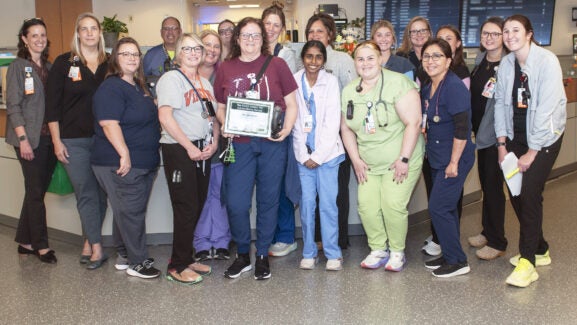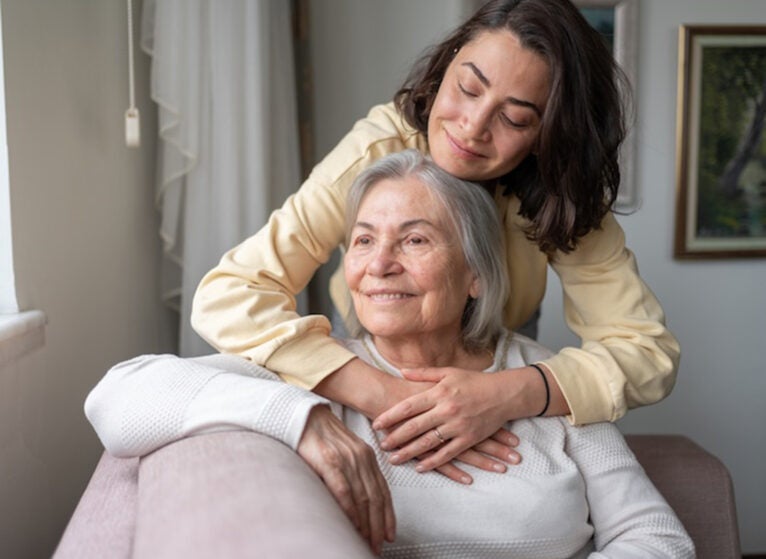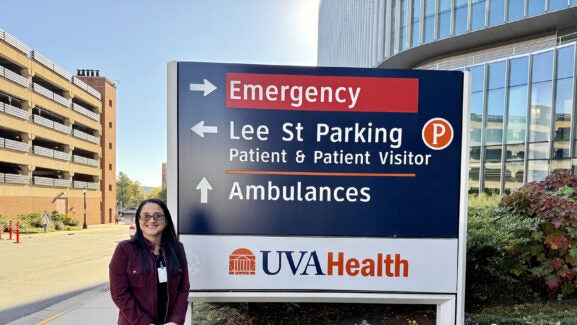

Research Breakthroughs Lead to Potential New Parkinson’s Drug
AbbVie Pharmaceuticals has submitted a New Drug Application (NDA) to the federal Food and Drug Administration for the first novel drug treatment for Parkinson’s disease in more than half a century. The drug tavapadon selectively activates a brain target called the D1 dopamine receptor. Its potential as a new treatment for Parkinson’s disease and other disorders was pioneered by UVA School of Medicine Professor of Pharmacology and Neuroscience Richard B. Mailman, PhD.
More than 11 million people around the world are living with Parkinson’s, and the condition is the fastest growing age-related neurological disease. Parkinson’s causes tremors — uncontrollable shaking — as well as stiffness, slowness, and difficulty moving. It increases the risk of falls and can come with symptoms such as fatigue, insomnia, memory loss, and impaired ability to concentrate. The major pathological change in Parkinson’s is the gradual death of nerve cells that make and use dopamine for function. Despite decades of research, no way has been found to stop this degeneration.
Current Therapy
The major breakthrough in therapy occurred a half-century ago when the drug levodopa was discovered. Levodopa is called “dopamine replacement” because it is converted into dopamine by the dopamine nerve cells that remain alive. It made a dramatic difference in both quality of life and lifespan of Parkinson’s patients and has been the gold standard treatment ever since. Unfortunately, levodopa requires some remaining dopamine nerve cells to work. Because these cells keep dying during the progression of Parkinson’s, levodopa eventually loses its effectiveness, or it causes intolerable side effects such as excessive movements (called dyskinesias) and mental confusion and hallucinations.
In theory, scientists can use drugs that mimic dopamine in the brain by activating proteins called dopamine receptors. These drugs are called “dopamine agonists” and many have been approved for human use. None of them, however, is as effective as levodopa, and they have many side effects that limit their use.
In 1984, Mailman did experiments that made him realize all of the existing “dopamine agonists” targeted a specific subset of receptors called “D2-like.” His experiments suggested that the other type of dopamine receptor (“D1-like”) actually was responsible for most of levodopa’s beneficial effects. He also suspected targeting D1-like receptors would not have many of the side effects of the approved “dopamine agonist” drugs.
He formed a team to discover a new drug that would get into the brain and bind only to the D1 dopamine receptor. Over many years, his team was successful and showed that the experimental drug was as effective as levodopa in animal models of Parkinson’s disease and in people. His findings were confirmed by other scientists and by clinical research from a major pharmaceutical company, all of whom found that a D1 agonist (unlike the approved dopamine agonists) works as well as levodopa in people with Parkinson’s disease.
Challenges in Translating Research
In late 1990s, the excitement of this new discovery was hindered by the fact that all of these the first-generation drugs were only injectable. When administered incorrectly (e.g., injected by vein), they caused unacceptable drops in blood pressure. During this time, a new addition to the research team, Xuemei Huang, MD, PhD, was training as a movement disorder specialist and clinical researcher. Working at Emory University with Jose Juncos and the late Mahon Delong, MD, she designed a clinical study that showed that D1 agonists could be administered in a way that avoided the blood pressure problems. This finding indicated that an oral drug of this type could be used for therapy. Huang is now Nina and Ken Botsford Bicentennial Professor and Chair of UVA Department of Neurology and has continued her research in these areas.
Medicinal Chemistry Advances Open the Door
While continuing his basic lab research, Mailman continued to try to convince pharmaceutical companies, large and small, on the importance of this approach to Parkinson’s patients. He persisted despite the overall feeling the industry that the Parkinson’s market was “too small” to be worth an investment.
The breakthrough came in 2007 when he was invited to visit Pfizer to discuss the clinical potential of D1 agonists. Although Mailman did not realize it at the time, this visit convinced a Pfizer team led by Dr. David Gray of both the medical and business impact of discovering a D1 agonist and the importance to have a pill rather than as an injection.
Gray later noted he, too, had faced skepticism about this idea, but his innovative medicinal chemistry was the crucial step towards getting a drug into the clinic. In 2017, Pfizer publicly announced that its D1 agonist program for Parkinson’s at an international congress. At that meeting, Mailman introduced Huang to Pfizer to discuss exciting laboratory data suggesting novel treatment of advanced (late-stage) Parkinson’s, for which there is no medical option. Pfizer agreed to help with a clinical trial that Huang and her team later executed successfully.
In 2018, Pfizer transferred the D1 agonist drug program to Cerevel Therapeutics, a new company that led the final clinical trials. Cerevel was acquired by AbbVie in 2024.
FDA Application
AbbVie’s announcement on Sept. 26 of a New Drug Application for tavapadon is the last step before the drug could become available to general patient use. Tavapadon is designed to increase the amount of time when Parkinson’s patients have control of their symptoms and requires them to only take medicine once per day. Clinical trials show that it may be used alone or in conjunction with levodopa.
Effect on Quality of Life
Levodopa has been the standard for patients with Parkinson’s disease, offering a “honeymoon” period that no other drug has matched. In clinical practice, levodopa requires multiple doses every day at more frequent intervals, while tavapadon will require only one dose per day. It also may provide patients with more advanced Parkinson’s a “second honeymoon” in terms of excellent control of their motor symptoms. Finally, Mailman’s team has shown that a drug like tavapadon may provide impressive benefits in the very late stages of PD when patients are confined to wheelchair or bed care. An initial small clinical trial led by Huang in the first-ever study of this stage of the disease yielded positive results.
“Dr. Mailman’s decades-long journey to make lab ideas work in the clinic is a wonderful story about the importance of scientific research and dedication to an idea even when it was not generally accepted,” Huang says. “When my movement-disorder colleagues and patients asked when tavapadon will be available, I have a warm feeling inside when I say ‘soon.’”
Mailman adds, “This announcement from AbbVie culminates an idea that has taken 40 years to bring to fruition. I was very pleased to be recruited to UVA to continue this exciting research. UVA has outstanding scientific collaborators, and the Manning Institute’s mission to accelerate the development of new treatments and cures for the most challenging diseases was a major attraction for me.”
“I look forward to sharing my knowledge and seeing the impact of this new category of drug to transform how we treat Parkinson’s patients. We also are researching how it may impact other disorders where D1 receptors may play a critical role, such as cognition, ADHD and autism,” he explains. “I was excited to be recruited to UVA because of colleagues like Kevin Pelphry, Jeff Elias, Binit Shah, Anita Clayton, Nikolay Dokholyan, and others with complementary expertise.”
Mark T. Esser, PhD, Chief Scientific Officer and Head of UVA Paul and Diane Manning Institute of Biotechnology, adds: “It has been a pleasure to meet and start working with Drs. Mailman, Huang and their team since I arrived. Their story underscores the importance of teamwork and perseverance as the journey to success is never a straight line and often long. The Manning Institute will bring together the critical ingredients of persistence, passion and people with the right skills to work together under ‘one roof’ to transform science into medicines.”
About the Clinical Trials
Tavapadon has been tested in two Phase 3 clinical trials, TEMPO-1 and TEMPO-2, that enrolled people who had been diagnosed with Parkinson’s for less than three years. A third Phase 3 trial, TEMPO-3, looked at the drug’s effects in patients taking levodopa but still experiencing problems with motor control.
The TEMPO-1 and -2 trials found that patients who received tavapadon (versus a placebo) showed a statistically significant improvement in their movement problems, while TEMPO-3 showed that combining tavapadon and levodopa increased the amount of time each day when trial participants were free of dyskinesia or involuntary movements.
In addition to the results from the completed trials, AbbVie said it has also submitted to the FDA early results from the ongoing TEMPO-4 study that is examining the long-term safety and efficacy of tavapadon through 58 weeks of treatment.
The most common adverse reactions to tavapadon were nausea, headache, and dizziness, while the most common adverse reactions among those taking both tavapadon and levodopa were nausea and dyskinesia.
While Mailman and Huang are inventors on patents related to D1 agonists, neither will have any financial gain from the marketing of tavapadon if it is approved by the FDA.
To keep up with the latest medical research news from UVA, subscribe to the Making of Medicine blog.
Latest News



